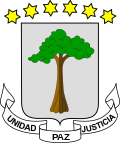| Demographics of Equatorial Guinea | |
|---|---|
 Population pyramid of the Equatorial Guinea in 2020 | |
| Population | 1,679,172 (2022 est.) |
| Growth rate | 3.5% (2022 est.) |
| Birth rate | 29.95 births/1,000 population (2022 est.) |
| Death rate | 8.95 deaths/1,000 population (2022 est.) |
| Life expectancy | 63.7 years |
| • male | 61.44 years |
| • female | 66.03 years |
| Fertility rate | 4.26 children born/woman (2022 est.) |
| Infant mortality rate | 78.33 deaths/1,000 live births |
| Net migration rate | 13.96 migrant(s)/1,000 population (2022 est.) |
| Age structure | |
| 0–14 years | 38.73% |
| 65 and over | 3.92% |
| Sex ratio | |
| Total | 1.15 male(s)/female (2022 est.) |
| At birth | 1.03 male(s)/female |
| Under 15 | 1.08 male(s)/female |
| 65 and over | 0.87 male(s)/female |
| Nationality | |
| Nationality | Equatorial Guinean |
| Major ethnic | Fang (85.7%) |
| Language | |
| Official | Spanish |
| This article is part of a series on the |
| Culture of Equatorial Guinea |
|---|
 |
| Society |
| Topics |
| Symbols |

Demographic features of the population of Equatorial Guinea include population density, ethnicity, education level, health of the populace, economic status, religious affiliations and other aspects of the population.
Contents
- Population
- Vital statistics
- Demographic and Health Surveys
- Life expectancy
- Ethnic groups
- Native ethnic groups
- Recently immigrated peoples
- Languages
- Languages of traditional names
- Other demographic statistics
- Population 2
- Languages 2
- Religions
- Age structure
- Population growth rate
- Birth rate
- Death rate
- Total fertility rate
- Median age
- Contraceptive prevalence rate
- Net migration rate
- Dependency ratios
- Urbanization
- Sex ratio
- Life expectancy at birth
- Literacy
- Major infectious diseases
- See also
- References
- External links

